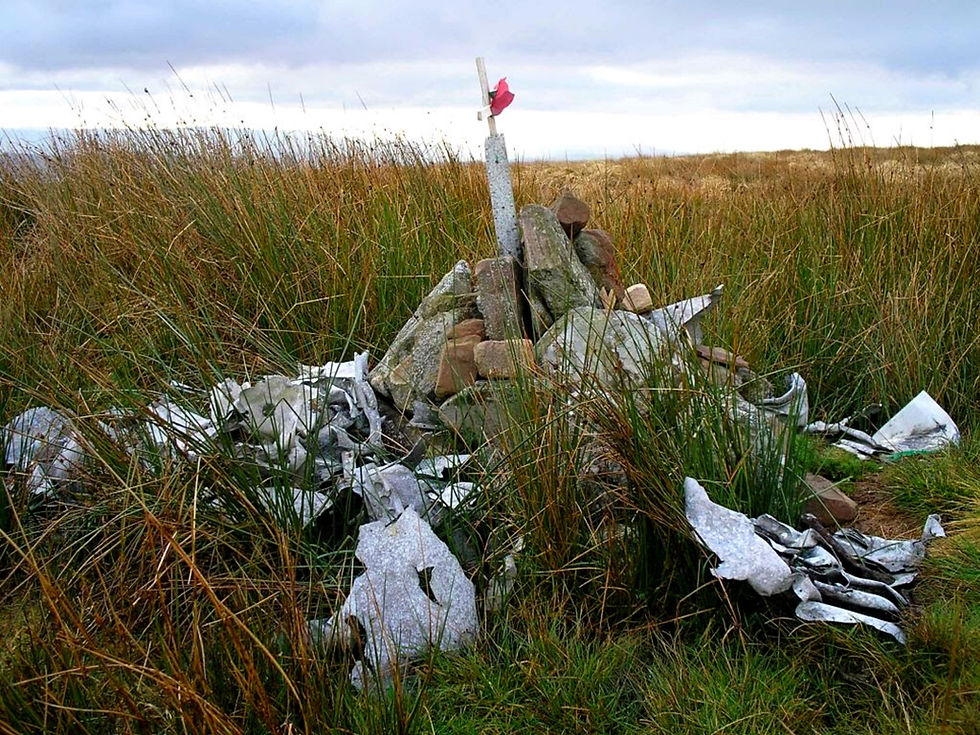Discover the Brecon Beacons Crash Sites
- Jay Curtis
- Mar 5, 2021
- 3 min read
Updated: May 4, 2021
In my opinion it’s one of the most picturesque parts of our landscape, but hidden among this mountainous expanse lies a long history of tragedy. As well as being home to Pen y Fan, Dan yr Ogof, Waterfall Country and acres of remote beauty, it also has a long history as a military training ground and remains the site of multiple crash sites from throughout WW2.

The sprawling terrain of the Brecon Beacons National Park has long been my backyard and stretches from west to east Wales.
Some are more well-known than others and many as 40 aircraft have come down in the Beacons in the past 80-odd years. While many parts have been removed by walkers throughout the years, some of the wreckage is still visible today.
Day 1: Wellington bomber, Carreg Goch & Vampire fighter jet, Fan Hir
Where to start the walk?
The site of the Wellington bomber sits high above Carreg Goch and is around 3km west of Glyntawe on the A4067. The mountain walk begins below Dan yr Ogof showcaves outside the campsite gate.
Climbing up the mountain trail leads you to the remains of the metalwork around grid reference SN817168. This includes a large section of each wing and the wheel along with other parts can be found far from the main cluster, northwards towards the River Giedd: demonstrating the violent nature of the crash.

History:
On the night of 20th November 1944, the Wellington bomber call sign MF509 was flying from 22 Operational Training Unit, Wellesbourne, Mountford, on a cross country exercise, when it developed trouble in the starboard Hercules XVI engine. Ultimately, the aircraft flew into clouds, building up heavy layers of ice on the wings and with insufficient power from the port engine, the aircraft lost height and crashed into Garreg Goch killing all six Canadian crew members.
Only back in 2005, some 60 years after the crash, did the families know the specific fate of their loved ones after an image was placed on the Internet in an effort to identify the crew.
A stone and concrete memorial marks the centre of the site and all the crew were buirried at the Canadian War Cemetery at Blacon, Chester, in England.
Vampire fighter jet, Fan Hir
During the walk there is also an opportunity to travel further up the Black Mountain region to find the single seater De Havilland Vampire FB5 site which lies around 4km north-north-east of the Wellington bomber at grid reference SN826201.
This wreckage can also be reached from Llyn y Fan Fawr by parking in the hamlet of Llandeusant to the north and descending down the mountain.

History:
The aircraft was brought into service at the war’s close in 1945, this particular plane crashed eight years later, on October 9th 1953, after mistakenly descending into the mountainside out of thick cloud. Pilot Officer John Raymond Baldock was on an exercise from nearby RAF Pembrey when he struck the ground at high speed killing him instantly.
Day 2: Spitfire fighter plane, Craig Fan Ddu
Where to start the walk? Day 2 starts at the Storey Arms or from the Neuadd Reservoir approach climbing some 5km south of Pen y Fan up to Craig Fan Ddu ridge to the remains of the Spitfire crash site at SO0118.
Sadly, very little of the aircraft remains apart from some twisted mental which also forms part of the memorial. Thus can also be one of the more difficult sites to locate.
The site is minimal in comparison to the other two sites and only recognisable as such by being gathered around a small cairn, marked with a perspex plaque and some aircraft remains.
However, If your feeling adventurous, the route can include the horseshoe walk which also takes in the highest peaks in the Brecon Beacons - Corn Du, Pen y Fan and Crybin.

History:
In May 1942, Spitfire X4588 of 53 Operational Training Unit RAF Llandow, piloted by Sergeant Donald Perry Carruthers of the Royal Canadian Air Force, took off to take part in a formation flying exercise.
Once again a combination of bad weather and a small error in navigation resulted in the aircraft becoming detached from the formation. The aircraft subsequently crashed on the summit of Graig Fan Ddu, killing Sgt Carruthers.
This incredible landscape and remote beauty remains a fitting memorial to the sacrifices made by others to preserve the freedoms we often take for granted today.

Comments